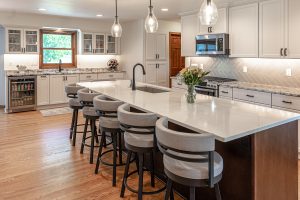 “One of the more critical elements of a good kitchen design involves lighting,” said Danni Maddison, a designer with Callen Construction, Inc. “The proper lighting mix enhances the form and function of the kitchen.”
“One of the more critical elements of a good kitchen design involves lighting,” said Danni Maddison, a designer with Callen Construction, Inc. “The proper lighting mix enhances the form and function of the kitchen.”
Danni explained there are three basic layers of lighting — ambient, task, and accent.
Ambient is the soft overhead light that illuminates the floor and walls so you can easily navigate the space you are in. They can include ceiling flush-mounts, recessed lighting, pendants, and chandeliers.
Task lighting is bright, focused light that goes over specific work areas, such as sinks, stoves, islands, where food is prepped, or inside a pantry so you can see what goods are on the shelves.
Accent lighting creates visual interest and dimension and often highlights a certain area such as a coffered ceiling or other architectural feature.
“Most kitchen remodels now include an island, but its purpose must be considered for the proper light fixture,” Danni said. “If the island is designed for a cooktop and food prep, then we recommend a mixed use of recessed down lighting and pendants. If the island has seating and serves as a gathering place, then pendant lights will do.
“Depending on the island size, you want to consider lighting that pops. Perhaps two or three large pendants or one statement hanging light, such as a chandelier, which come in designs to fit every style – contemporary, farmhouse, mid-century modern, or the more formal crystal.”
Other kitchen areas that need task lighting besides the stove or cooktop are sinks and countertops where you may also be preparing food or inside a pantry so you can see what goods are on the shelves. Over the sink, a flush-mount is an option as well as a pendant for a little more flair. For countertops, undercabinet lighting is a good choice because it illuminates the workspace without shadows. If the countertop has a lip, undercounter lighting is an option, which will more clearly illuminate what is inside an open drawer.
Accent lights add the finishing touch, creating visual interest and dimension. Danni recommends adding soft accent lighting inside a glass-front cabinet to highlight fine china, statement dishes, or pottery collections, for example.
Toe-kick lights can be considered accent lighting. Installed underneath base cabinets, they illuminate the floor, adding aesthetic appeal for the entire kitchen, as well as serving as a night light.
Over-cabinet lighting, between the cabinet and the ceiling, provides additional soft illumination and can also accent décor and architecture.
“Another element we recommend is pairing lights with dimmers for each type of lighting,” she said. “You might not always need bright lighting. You can adjust dimmers to whatever illumination you require. Whether setting the mood for a dinner party or conversation, or you just want a nice accent at night, we always recommend dimmers.”
When choosing bulbs, you need to consider again whether it is task or ambient lighting. Bulbs are measured in Kelvins, the number that describes the relative color appearance of a white light source, indicating whether it appears more yellow/gold (warm) or more blue (cool) in terms of the range of available shades of light.
A rule of thumb on Kelvin color temperature is a lower Kelvin (K) number means the light appears more yellow: high Kelvin numbers mean the light is whiter or bluer. For example:
- Less than 2000K — gives off a dim glow of light, similar to what you might find from candlelight; best for low-light areas where ambient illumination is welcomed.
- 2700 to 3000K — works for accent lighting to backlight a design element.
- 3500K to 4100K — a sharper light for task lighting.
- 4600K-6500K — similar to that of daylight; best for areas and work environments where very bright illumination is needed.
“When designing your kitchen lighting, in addition to the placement of appliances and work surfaces, we consider the amount of natural light, ceiling height, and surface finishes,” Danni said. “If natural light is lacking, we will recommend incorporating a window or even a skylight. When we design a kitchen, we get very detailed on placement to ensure layers of light for tasks, atmosphere, and style.”
Call Callen to discuss the best kitchen design for you and your home.


